|
Pinning Hopes on Goodwill
by Bob Brooke
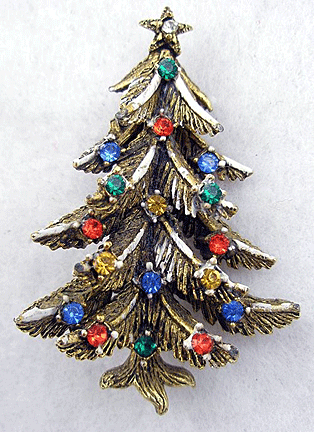 The
variety of styles and designs of Christmas tree pins is endless.
Besides these eight major producers, there were at least seven
others. Each created pins that brought hope and goodwill to those
wearing them, as well as those viewing them on the wearer. The pins
brightly said “Merry Christmas” to one and all. The
variety of styles and designs of Christmas tree pins is endless.
Besides these eight major producers, there were at least seven
others. Each created pins that brought hope and goodwill to those
wearing them, as well as those viewing them on the wearer. The pins
brightly said “Merry Christmas” to one and all.
Production of Christmas jewelry began in the late 1940s after the
end of World War II. Before then, women wore a Christmas corsage on
their coat or dress during the holiday season. These little personal
decorations consisted of cloth holly leaves, artificial berries,
ribbon, tiny plastic bells and just about anything lightweight.
Because of their fragility, these decorations would only last for
one holiday season and need to be replaced for the following one.
Beatrix
Founded in 1946 in Providence, Rhode Island., Beatrix discovered
success with a Christmas pin depicting a hand-painted holly leaf
with a red berry. From the 1950s until 1966, the company made only
modest changes such as adding snow or a couple of bells.
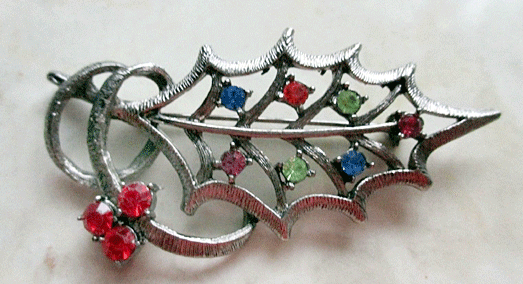
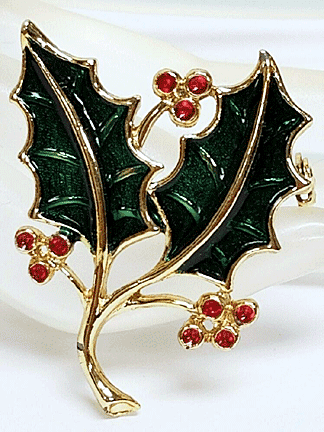 Eventually,
Treasure Master, a company that distributed commemorative wedding gifts,
joined forces with Beatrix for a new line of holiday jewelry. Bather
than stay with one simple design, Beatrix began manufacturing more than
1,000 different types of jewelry, which Treasure Master marketed. Among
the most popular designs was Chris Mouse, an adorable Yuletide rodent
posed in a variety of winter activities, who was eventually paired with
his girl-friend, Chris Miss Mouse. Eventually,
Treasure Master, a company that distributed commemorative wedding gifts,
joined forces with Beatrix for a new line of holiday jewelry. Bather
than stay with one simple design, Beatrix began manufacturing more than
1,000 different types of jewelry, which Treasure Master marketed. Among
the most popular designs was Chris Mouse, an adorable Yuletide rodent
posed in a variety of winter activities, who was eventually paired with
his girl-friend, Chris Miss Mouse.
Beatrix went out of business in 1983. Their holiday jewelry sells for
$10 to $25 for an enameled Christmas tree with rhinestones to $35 to $45
for a late l960s Mrs. Claus playing tennis.
Eisenberg
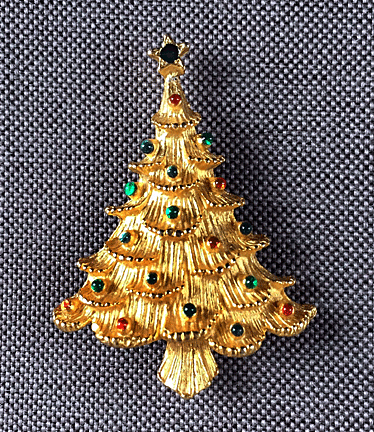 When
it comes to costume jewelry, Eisenberg tops the list. The Chicago based
company entered the Christmas pin market in the early 1950s. When
it comes to costume jewelry, Eisenberg tops the list. The Chicago based
company entered the Christmas pin market in the early 1950s.
Among its best-sellers was a tree-shaped pin having molded Christmas
balls. The firm produced different variations of the pin, including a
gold version with multicolored stones and a silver one with blue stones.
Early examples of Eisenberg jewelry can be difficult to distinguish,
since the company didn’t mark its pins or used paper labels that were
easily removed. When Eisenberg began stamping its jewelry, it first used
an "E"mark. Later examples carry the name "Eisenberg."
Prices range from $I5 to $25 for recently issued wreaths. But it’s most
famous for its glass tree produced in the mid-1970s. This tree in a
silver metal frame holds a foil-backed piece of glass, with rhinestones
set into the face of the tree. it sells for $175 to $300, but it’s rare.
Gerry's Creations
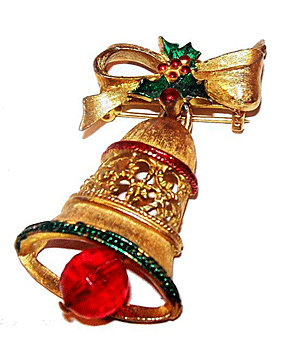 Like
many other companies, Gerry's Creations didn't mark its Christmas pins
when the company began production in New York City in the early 1950s.
Since the mid1950s, however, the company's jewelry has been stamped
"Gerry's" Like
many other companies, Gerry's Creations didn't mark its Christmas pins
when the company began production in New York City in the early 1950s.
Since the mid1950s, however, the company's jewelry has been stamped
"Gerry's"
Its most popular pins were its early ones, including a Victorian bell,
old street lamp and moveable poodle. The company continues to produce
holiday-related jewelry that generally sells for about $10.
Prices begin at $10 to $15 for a 1994 snowman on skis, while a 1950s
boot with a moveable poodle lists for $45 to $55.
Hobe
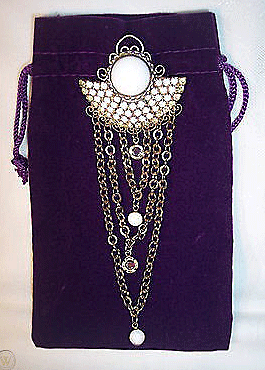 Hobe
got into the Christmas jewelry making business in the 1950s with its
rhinestone tree designs and a free-form design with dangling beads. Hobe
trees average from $45 to almost $200. New designs were issued annually
until the early 1990s. Hobe
got into the Christmas jewelry making business in the 1950s with its
rhinestone tree designs and a free-form design with dangling beads. Hobe
trees average from $45 to almost $200. New designs were issued annually
until the early 1990s.
Rhinestone angels, bells, trees and stick pins show the variety of
styles produced by Hobe, which is now based in Mt. Vernon, New York.
Many 1960s designs that were reissued in the 1980s can be purchased for
$25 to $45, while a 1976 Christmas tree sells for $65 to$85.
Hollycraft
A division of the Hollywood Jewelry Co., Hollycraft made Christmas pins
from 1948 to the early 1960s. This firm not only stamped some of its
pins but also dated them.
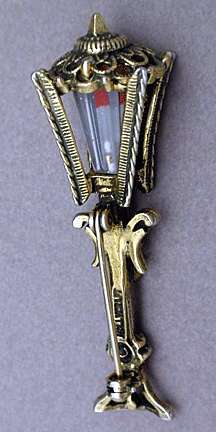 Although
Hollycraft is known for its costume jewelry with pastel-colored stones,
the company's line of Christmas goodies actually used brighter colors
more in line with the season. Although
Hollycraft is known for its costume jewelry with pastel-colored stones,
the company's line of Christmas goodies actually used brighter colors
more in line with the season.
Its pins came in a variety of styles, including trees, holly-decorated
street lamps and Santas. The best examples will have rhinestones set in
prongs, while less expensive examples use glue to keep the rhinestones
in place.
One of the most sought after is the beaded tree that has beads dangling
from the branches. It sells for $135 to $225. The matching earrings sell
for $110. Other Hollycraft trees start at $75.
Values range front S45 to $65 for plain Christmas trees to $150 to 52110
for a dated 1959 example. An unusual late 1950s or early1960s Santa
lists at $95 to $110.
Jonette
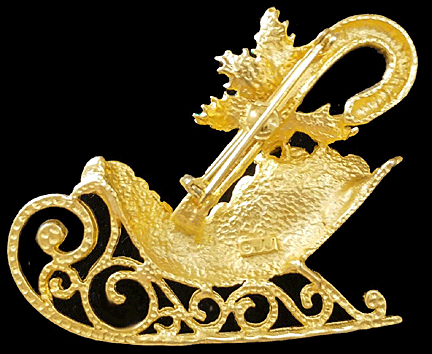 Founded
in the late 1930s as Providence Jewelry Company in Providence, Rhode
Island, it took several name changes before the company became Jonette
Jewelry Company after World War II. It first introduced Christmas pins
in the late 1940s, with new designs issued every year. Founded
in the late 1930s as Providence Jewelry Company in Providence, Rhode
Island, it took several name changes before the company became Jonette
Jewelry Company after World War II. It first introduced Christmas pins
in the late 1940s, with new designs issued every year.
The variety of Jonette jewelry includes Christmas trees, Santos, sleighs
and a Christmas door that opens. Marked examples are stamped "J.J.."
Examples from the 1990s include candy canes at $12 to MR, a door that
opens at $35to $45, and a sleigh at 545 to $65. A 1950s Christmas tree
books at $65 to $75.
Trifari
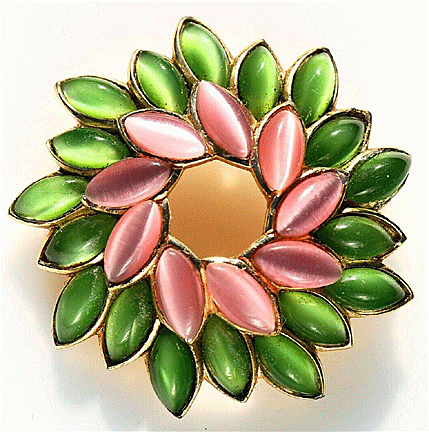 The
Trifari Company went into business in 1918, but Christmas pins weren't
added to the line until the early 1950s. Marked examples bear the
“Trifari” name on the back. Today, the company is owned by The Monet
Group in New York City. The
Trifari Company went into business in 1918, but Christmas pins weren't
added to the line until the early 1950s. Marked examples bear the
“Trifari” name on the back. Today, the company is owned by The Monet
Group in New York City.
Christmas trees issued in 1972 today sell for $55 to $75, while a 1961
example with jelly-like crystals sells for $85 to $110.
Weiss
Weiss produced jewelry from 1942 until the early 1970s. The firm’s line
featured numerous Christmas designs, including a geometric, rhinestone
Christmas tree that came in three sizes. Though Weiss' trees command top
prices, the company produced other popular pins, including sleds,
wreaths, ornaments, stockings, and poinsettias.
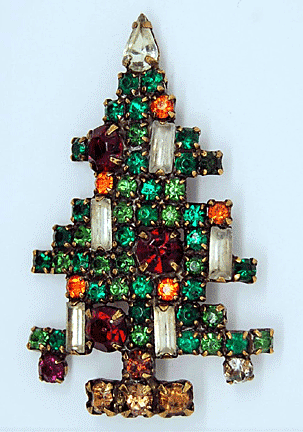 Look
for "Weiss" stamped in an oval disc on the company's pins. Unmarked
examples can also be found, but they‘re less desirable since Weiss sold
this generic jewelry in boxes carrying the store's name. Other unsigned
jewelry came from jobbers who cast designs from Weiss molds. Look
for "Weiss" stamped in an oval disc on the company's pins. Unmarked
examples can also be found, but they‘re less desirable since Weiss sold
this generic jewelry in boxes carrying the store's name. Other unsigned
jewelry came from jobbers who cast designs from Weiss molds.
The Weiss Six Candle Tree has become one of the most sought after of
Christmas pins. The 2 ½-inch pin has all prong-set stones, deep green
for the tree and red for the ornaments, with clear rectangular stones
for the candles and yellow round stones for the flames. The Five Candle
Tree is just over two inches tall, ad the Three Candle Tree is less than
2 inches tall. The former is valued at $150 to $325 and the latter is
$125 to $225 and the Three is $135 to$185.
Sleigh shaped pins from the 1960s and '70s begin at $35 to $45, while
prices climb steadily from there. The largest size 1940s Christmas tree
is valued at $125 to $225.
<
Back to More Antique Spotlights
Next Article >
|
